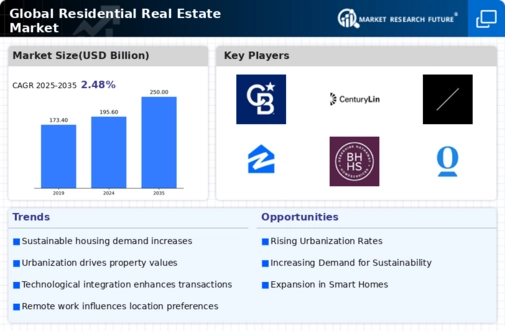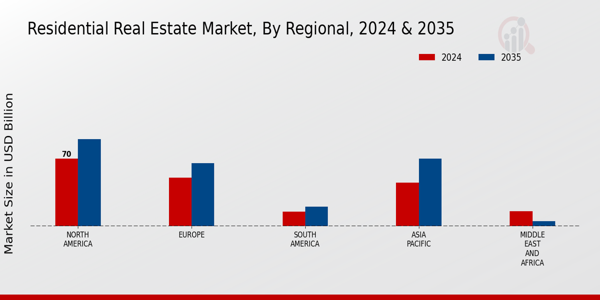Demographic Shifts
Demographic shifts are a key driver of the Global Residential Real Estate Market Industry, as changes in population dynamics influence housing demand. For example, the aging population in many developed countries is leading to increased demand for retirement communities and accessible housing options. Conversely, younger generations are seeking urban living spaces that offer convenience and connectivity. These demographic trends suggest that the market must adapt to cater to diverse needs, potentially leading to a more varied housing stock. As the population continues to evolve, the Global Residential Real Estate Market Industry will likely experience shifts in demand patterns, necessitating strategic responses from developers and investors.
Urbanization Trends
The Global Residential Real Estate Market Industry is significantly influenced by urbanization trends, as more individuals migrate to urban areas in search of better employment opportunities and living conditions. As of 2024, the market is valued at approximately 195.6 USD Billion, reflecting the increasing demand for housing in metropolitan regions. This urban influx drives the need for residential properties, leading to a surge in construction and development projects. Furthermore, by 2035, the market is projected to reach 250 USD Billion, indicating a robust growth trajectory. Urbanization not only enhances property values but also stimulates local economies, thereby reinforcing the importance of the Global Residential Real Estate Market Industry.
Technological Advancements
Technological advancements play a pivotal role in shaping the Global Residential Real Estate Market Industry. Innovations such as smart home technology, virtual reality tours, and online property management systems have transformed how properties are marketed and managed. These technologies enhance the buying and renting experience for consumers, making it more efficient and user-friendly. As the industry adapts to these changes, it is likely to attract a broader demographic, including tech-savvy millennials and Gen Z buyers. The integration of technology is expected to contribute to the market's growth, supporting the projected CAGR of 2.26% from 2025 to 2035.
Economic Growth and Stability
Economic growth and stability are fundamental drivers of the Global Residential Real Estate Market Industry. A robust economy typically correlates with increased disposable income, enabling individuals to invest in residential properties. In 2024, the market is valued at 195.6 USD Billion, reflecting the positive economic conditions that support real estate investments. As economies recover and grow, the demand for housing is expected to rise, contributing to the projected market expansion to 250 USD Billion by 2035. Furthermore, stable economic conditions foster consumer confidence, which is crucial for sustaining long-term growth in the Global Residential Real Estate Market Industry.
Government Policies and Regulations
Government policies and regulations significantly impact the Global Residential Real Estate Market Industry, influencing everything from zoning laws to tax incentives for homebuyers. In many regions, favorable policies aimed at increasing homeownership rates can stimulate demand for residential properties. For instance, various countries have implemented first-time homebuyer programs, which can lead to increased sales and construction activity. Additionally, regulatory frameworks that promote sustainable building practices may also shape market dynamics. As the market evolves, these policies will likely continue to play a crucial role in determining the trajectory of the Global Residential Real Estate Market Industry.
Market Trends and Consumer Preferences
Market trends and consumer preferences are essential components of the Global Residential Real Estate Market Industry. As buyers become more environmentally conscious, there is a growing demand for sustainable and energy-efficient homes. This shift in consumer preferences is prompting developers to incorporate green building practices and eco-friendly materials into their projects. Additionally, the rise of remote work has altered housing preferences, with many individuals seeking larger homes in suburban areas rather than urban centers. These evolving trends indicate a dynamic market landscape, where adaptability to consumer demands will be critical for success in the Global Residential Real Estate Market Industry.























Leave a Comment